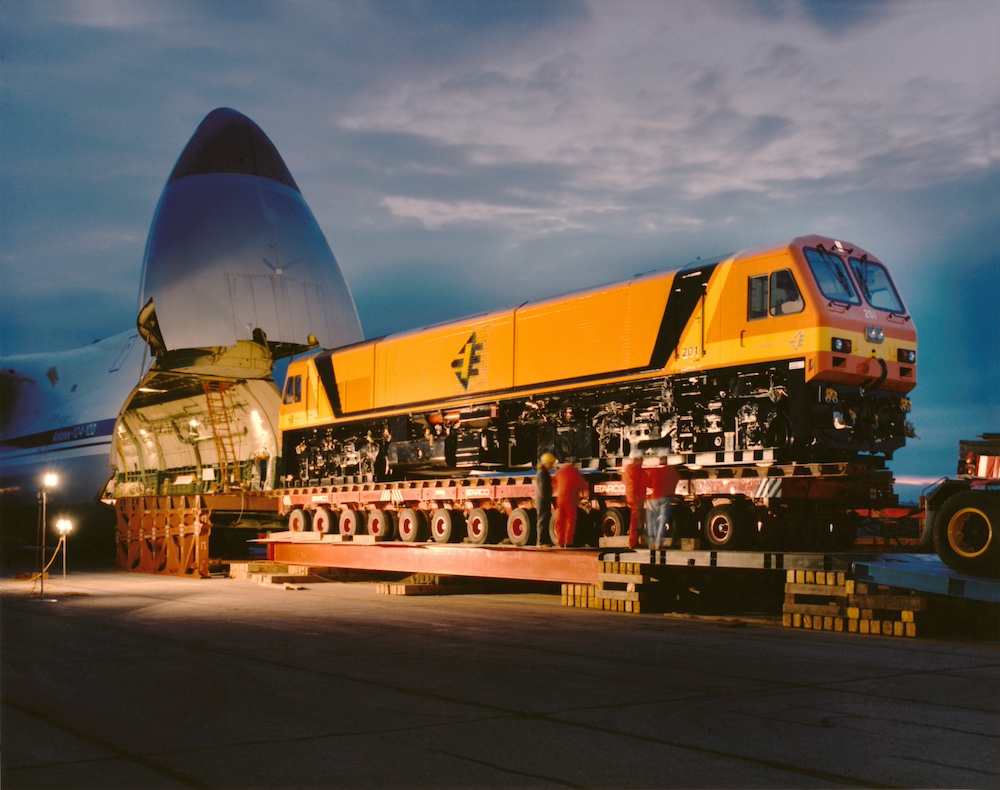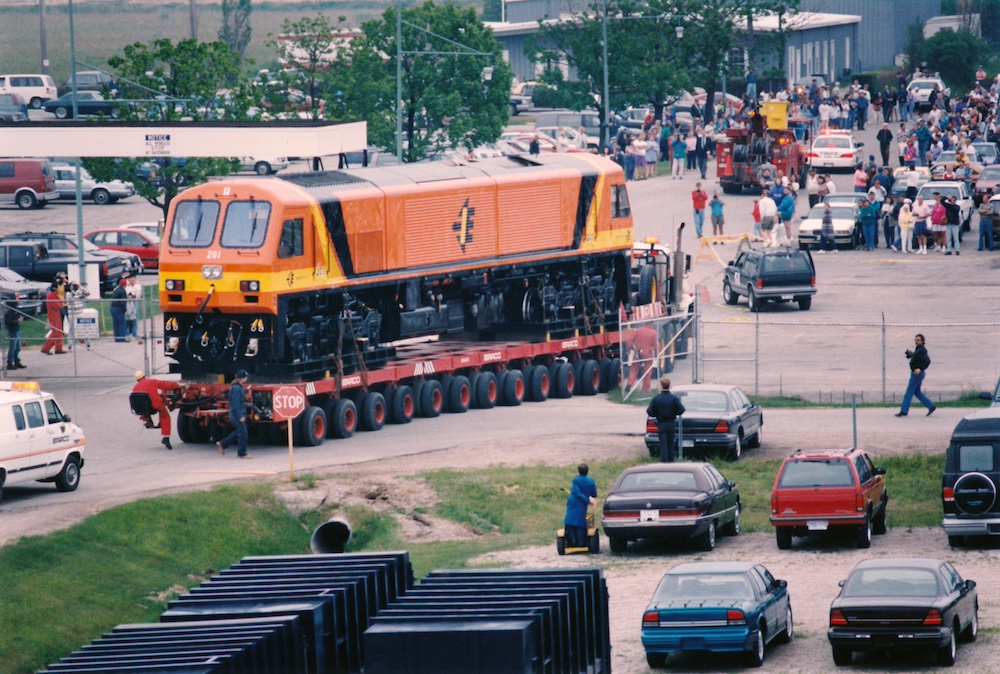Irish Rail

It was the early 1990s and I was an Electro-Motive Division export locomotive district sales manager in the International Locomotive Business Group, based at EMD’s headquarters in LaGrange, Ill. At the time, I was responsible for our locomotive and spare parts sales in Europe, and one of my customers was Irish Rail. During this time, locomotive procurement activity was starting to brew at the railway.
Irish Rail received its first EMD locomotives in January 1961. The locomotives, model GL8s, were an instant success. Irish Rail’s management was satisfied with the reliability and low maintenance costs of its EMD fleet and wanted to stick with us. However, our rival General Electric was after the business as well and had partnered with Great Britain’s Brush Electrical Machines Ltd., with Brush serving as its main contractor. Moreover, GE was in the process of buying the large fleet of aircraft operated by Ireland’s Guinness Peat Aviation and was working closely with Ireland’s Minister of Transport. General Electric would certainly try to leverage this high-level access into a locomotive order. This possibility had Irish Rail worried GE would win the contract. Their concern led to EMD’s general manager (who was also a vice president of General Motors) making several calls on Irish Rail with me — he was a locomotive salesman at heart!
The first Irish Rail tender was for 10 locomotives. We won the order with our JT42HCW locomotive (J = cab at both ends / T = turbocharged engine / 4 = 4th generation of engine / 2 = 12-cylinder engine / H = head-end power / C = Co-Co six traction motors – six axles / W = standard gauge or wider). The locomotive would be equipped with EMD’s 12-710G3B engine rated at 3,200 hp, an AR8PHEH/CA6B main generator, Dayton Phoenix head-end power alternator, D43 traction motors and EM2000 microprocessor control system, including Super Series wheel creep control.
To fully operate the head-end power (HEP) system, the locomotive’s diesel engine had to run at a constant 900 rpm. In standby mode, the engine still had to run at a constant 600 rpm — still a relatively high rpm for a 3,200-horsepower diesel. We were concerned there would be noise complaints when passenger trains entered locomotive-first under Dublin’s covered Heuston station with the engine roaring, but Irish Rail’s managing director, Dave Waters, insisted on head-end power. It would eliminate the use of a power generator car on a passenger train and make way for an additional revenue-generating car.
When Irish Rail’s Chief Mechanical Engineer John McCarthy visited us at LaGrange, we arranged for the chief mechanical engineer of Metra — Chicago’s commuter rail operator — to give us a tour of Chicago Union Station to see (and hear) Metra’s head-end powered EMD F40PH “thunder boxes” in action under the station’s covered platforms. McCarthy appeared unconcerned with the noise level.
Irish Rail’s managing director also wanted the new units equipped with dynamic braking. Since there was no space in the usual location, our engineers designed a system located in the engine cooling water compartment. When we agreed to provide this unusual dynamic braking arrangement, IR’s managing director assured us we would win the bid. We stayed with our “GC” bogies and they had to be capable of running at 100 mph between Dublin and Cork. We also had to stick with the Irish Rail standard of a dual control system in the cabs with the controls on both sides of the cab mechanically connected. Designing this locomotive was quite an engineering challenge, as the extra head-end power and dynamic braking equipment needed to be added while still maintaining an extremely light mandatory axle load of slightly more than 17 metric tons.
By this time, much of the locomotive production had shifted from EMD at LaGrange to our sister plant at London, Ontario, the Diesel Division of General Motors Canada Limited (DDGMCL). The new Irish Rail locomotives would be assembled in London. The underframes and traction motors were also manufactured at London, while EMD in LaGrange provided the diesel engines, main generators, electrical cabinets, and other miscellaneous items.
During production of the 10 Irish Rail locomotives at the DDGMCL plant, London was also handling orders for 350 Burlington Northern SD70MAC locomotives, 31 GT46CWM locomotives for the New South Wales Railways in Australia, and F59PHI locomotives for CalTrans. Thus EMD/DDGMCL went from no locomotive business to a great deal of business, and this resulted in the Irish Rail units falling behind on our delivery commitment.
The delay put me in an awkward position. Paul Conlon, executive chairman of Irish Rail, wanted to take part in the naming ceremony of the first unit — No. 201 — to be held at IR’s Inchicore Work in Dublin, its primary maintenance and overhaul facility. This would be Conlon’s swan song before his retirement, and it looked like the unit would not arrive in time.
I was discussing the lateness of No. 201 over breakfast with EMD’s general manager and nearly fell out of my chair when he said, in so many words, “Not to worry Russ, we’ll fly that baby to Dublin!”
Sure enough, Bill Burns, transportation manager at the Diesel Division General Motors Canada Limited plant in London, Ontario, arranged for an enormous Antonov 124-100 cargo plane, built in Ukraine in the then-Soviet Union, to fly No. 201 to Dublin on June 8, 1994.
To give you an idea of the magnitude of this project, it was not only the first-ever locomotive transported by air, but the shipment also set a then-world record for heaviest-ever commercial air cargo!

To transport No. 201 from the plant in London, Ontario, to the city’s airport, the locomotive was placed on a special truck trailer with rails on it set at the Irish Rail track gauge of five feet three inches. In the meantime, the Antonov crew had installed rails in the cargo hold of their aircraft. The trailer height was aligned to the aircraft’s floor, then the aircraft’s winches pulled the unit inside. Maintaining balance required a pair of 10-ton weights from the DDGMCL plant. As the locomotive inched into the aircraft, these weights were eased forward to maintain a level, balanced deck. (This painstaking process was repeated at the Dublin airport during unloading of the locomotive.)
The Antonov needed all the room the London, Ontario airport could offer, lifting off just as it reached the end of the runway!
The Antonov and its high-flying locomotive arrived at Dublin airport on the morning of June 9, 1994. Unloading commenced at 10 p.m. that night. No. 201 remained outside the aircraft all day on the 10th of June. The move on a truck from the Dublin airport through the streets of Dublin to Irish Rail’s Inchicore Works on the west side of Dublin commenced at 1 a.m. on June 11, much to the surprise of folks stumbling out of pubs!
Estimates of the cost of flying the 201 from London, Ontario, to Dublin, Ireland vary from $250,000 to as much as $750,000. (More than 25 years have passed and the wide variance shows the impact time has on people’s memories!) Factors included in the cost include the flight itself, disruption at the London plant, and movement by specialized trucks in Canada and Ireland.
Transit time from our London plant to Irish Rail’s Inchicore Works in Dublin was just over 48 hours. If No. 201 had been shipped by expedited ocean freight, the cost would have still been high — about $250,000 — and the transit time would have stretched to 14+ days.
The balance of the order, nine locomotives, traveled as regular sea cargo at $30,000 per unit.
Unfortunately, Paul Conlon, the soon-to-retire chairman of Irish Rail, was not able to attend the naming ceremony after all but another heavy-hitter substituted in his place — Noel Treacy, Ireland’s minister of state at the Department of Transport.
No. 201 was named in English on one side, “River Shannon,” and in Irish on the other side, “Abhainn na Sionnainne.” In addition to carrying its cast nameplate, the locomotive also sported the new Irish Rail corporate logo based on the Irish language name of the company — Iarnrod Eireann — also formally launched on this date.
Predictably, the head-end power system was soon deactivated due to noise complaints when operating in Dublin’s Heuston station, and Irish Rail resumed the use of power-generating cars. As it would turn out, HEP was only ever used when working the Dublin-Belfast Enterprise service with De Dietrich coaches.
Irish Rail went on to place additional orders for EMD’s JT42HCW locomotives; 20 units were delivered through March 1995 along with two “cross-border” JT42HCW units for dedicated passenger train service between Dublin, Ireland, and Belfast, Northern Ireland. Goodwill resulting from our gesture of flying the 201 to Dublin doubtless provided “insurance” we would win this additional business!
Gerry Beesley, who was Irish Rail’s maintenance planning engineer at their Inchicore Works when I commenced calling on Irish Rail, kindly furnished me with the following current status (as of December 2020) of the 201 class. The ten units delivered with plain traction motor suspension bearings (201-205 and 210-214) have been mothballed for several years. Although not officially withdrawn from service, they will unlikely run again. Of the other 24 units, those equipped with roller traction motor bearings (206-209 and 215-234), all but two are in the operational fleet. Unit 230 suffered a major fire because of a main traction alternator failure, and Unit 224 has a broken main frame. There is a rumor that Irish Rail may make one unit out of the two, but it would not be a priority job.













